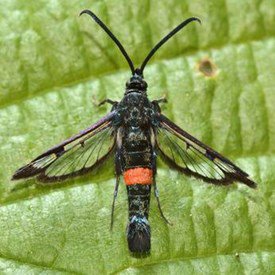Shaggy, smooth, papery–tree bark comes in all sorts of textures and shades. But no matter its appearance, that bark’s not just there for looks!
A tree’s outermost layer of bark protects it from outside stressors, like extreme temperatures, insects or pecking birds. So, when intruders break through the bark, it can be bad news for the tree.
Michelle, a Davey blog reader from New Jersey, saw this first-hand on her evergreens. She wrote, “The spruces in my front yard are becoming see-through with a lot of dead, bare branches. They have little holes in the main trunk, and the sap has dripped out. What is wrong with them?”
Read on to find out the top reasons why there are holes in your tree’s bark, like Michelle’s tree.
Do tree insects cause holes in tree trunks?
Certain pests, called borers, tunnel their way in, out, and around tree bark–and even the wood under bark! All that movement may leave behind teeny, tiny holes.
But they’re not the only culprits! Birds can do it, too.
So, who’s decorating your tree with their distinctive mark? The size and distribution of the holes will help you narrow it down.
What causes tiny holes in tree trunks?

Who done it: Marks as thick as a piece of spaghetti are often left by bark beetles or similar borers. There are tons of species. Most of them seek out weak trees that are stressed by environmental stress, improper watering, pruning injuries or other insect attacks.
What they do: These pests tunnel into the tree and lay eggs. Then, young borers chew through the tree, which disrupts its ability to transport food and water. That can kill the tree. Once the beetles grow up, they exit the tree, leaving a series of tiny holes as proof.
Other symptoms: Bark beetles often leave sawdust or little tubes of sap on the trunk as well. From there, look for browning foliage as well as early leaf or needle drop. If you think you have beetles or borers, act quickly.
What to do next: You can proactively treat for some borers (like emerald ash borer) and beetles (like pine bark beetles). But once you spot advanced symptoms, you often need to remove the tree.
What causes large holes in tree trunks?

Who done it: Clearwing moths create larger dime-sized craters. These moths also prefer weakened trees. Each species of this moth has their favorite type of tree. But trees like maple, ash dogwood, and cherry often top of the list.
What they do: Adult clearwing moths don’t damage trees themselves. Instead, the larvae that emerge from eggs deposited on the bark begin to tunnel, which could disrupt the tissues your tree needs to transport food and water.
Other symptoms: Check for a sawdust-like material near the holes or on the ground. Then, look up to see if there are any dead branches.
What to do next: Have an arborist confirm that it’s these moths doing the damage. While these don’t do as much harm, the warning signs they leave behind are very similar to boring beetles. Once you know it’s these moths, figure out if you’d like to treat–and how to improve your tree’s health!
What causes rows of holes in tree trunks?

Who done it: The yellow-bellied sapsucker, a member of the woodpecker family, is known for its precise tree damage. In search of sugary sap, the bird often opts for maple and apple trees. But they’ll go after lots of other tree species, too!
What they do: They feed on sap inside the tree and the insects that are drawn to it, like beetles and ants. Woodpeckers mainly eat the insects (not sap) hiding in your trees.
Other symptoms: Sapsuckers peck perfectly neat horizontal (or sometimes vertical) rows in tree bark. Their marks are impossible to miss. If you have an ash tree and the indentations are more sporadic, check your tree for other signs of the emerald ash borer. Woodpecker damage is often an early sign.
What to do next: Focus on deterring these birds using the tips below. If your tree is continually targeted, it could be in trouble.
Is there any way to repair sapsucker holes?
Unfortunately, there’s no way to patch up woodpecker damage. You can deter them, though, by wrapping the affected areas in burlap or small gap chicken wire.
That way, pecking birds can’t get to bark. Be sure to remove the covering after the sapsuckers’ migration is over in the spring and again in the fall. Also, these birds are protected under the Migratory Bird Act, so do not attempt to harm, capture or kill these birds.







